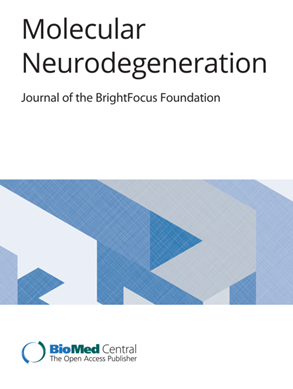Probe-dependent Proximity Profiling (ProPPr) Uncovers Similarities and Differences in Phospho-Tau-Associated Proteomes Between Tauopathies
IF 17.5
1区 医学
Q1 NEUROSCIENCES
引用次数: 0
Abstract
Tauopathies represent a diverse group of neurodegenerative disorders characterized by the abnormal aggregation of the microtubule-associated protein tau. Despite extensive research, the mechanisms underlying the diversity of neuronal and glial tau pathology in different tauopathies are poorly understood. While there is a growing understanding of tauopathy-specific differences in tau isoforms and fibrillar structures, the specific composition of heterogenous tau lesions remains unknown. Here we study the protein composition of tau aggregates in four major tauopathies: Alzheimer's disease (AD), corticobasal degeneration (CBD), Pick's disease (PiD), and progressive supranuclear palsy (PSP). We developed an approach for in situ proximity labeling and isolation of aggregate-associated proteins using glass slides with formalin-fixed paraffin-embedded (FFPE) human postmortem brain tissue, termed Probe-dependent Proximity Profiling (ProPPr). We used ProPPr for the analysis of proteomes associated with AT8-positive cellular lesions from frontal cortices. Isolated proximity proteomes were analyzed by data-independent acquisition mass spectrometry. Co-immunofluorescence staining and quantitative data analysis for selected proteins in human brain tissue was performed to further investigate associations with diverse tau pathologies. Proteomics data analysis identified numerous common and tauopathy-specific proteins associated with phospho-tau aggregates. Extensive validations of candidates through quantitative immunofluorescence imaging of distinct aggregates across disease cases demonstrate successful implementation of ProPPr for unbiased discovery of aggregate-associated proteins in in human brain tissue. Our results reveal the association of retromer complex component vacuolar protein sorting-associated protein 35 (VPS35) and lysosome-associated membrane glycoprotein 2 (LAMP2) with specific types of phospho-tau lesions in tauopathies. Furthermore, we discovered a disease-specific association of certain proteins with distinct pathological lesions, including glycogen synthase kinase alpha (GSK3α), ferritin light chain (FTL), and the neuropeptide precursor VGF. Notably, the identification of FTL-positive microglia in CBD astrocytic plaques indicate their potential role in the pathogenesis of these lesions. Our findings demonstrate the suitability of the ProPPr approach in FFPE brain tissue for unbiased discovery of local proteomes that provide valuable insights into the underlying proteomic landscape of tauopathies, shedding light on the molecular mechanisms underlying tau pathology. This first comprehensive characterization of tau-associated proteomes in a range of distinct tauopathies enhances our understanding of disease heterogeneity and mechanisms, informing strategies for the development of diagnostic biomarkers and targeted therapies.探针依赖的邻近分析(ProPPr)揭示了tau病之间磷酸化- tau相关蛋白质组的相似性和差异性
tau病代表了以微管相关蛋白tau异常聚集为特征的多种神经退行性疾病。尽管进行了广泛的研究,但不同tau病中神经元和神经胶质tau病理多样性的机制尚不清楚。虽然人们对tau亚型和纤维结构的tau病变特异性差异的了解越来越多,但异质tau病变的具体组成仍然未知。在这里,我们研究了四种主要tau病:阿尔茨海默病(AD)、皮质基底变性(CBD)、皮克病(PiD)和进行性核上性麻痹(PSP)中tau聚集物的蛋白质组成。我们开发了一种原位接近标记和分离聚集体相关蛋白的方法,使用福尔马林固定石蜡包埋(FFPE)人类死后脑组织的玻璃载玻片,称为探针依赖接近分析(ProPPr)。我们使用ProPPr分析与额皮质at8阳性细胞病变相关的蛋白质组。分离的接近蛋白质组通过数据独立获取质谱分析。对人类脑组织中选定的蛋白质进行了免疫荧光染色和定量数据分析,以进一步研究与多种tau病理的关联。蛋白质组学数据分析确定了许多与磷酸化tau蛋白聚集体相关的常见和tau病特异性蛋白质。通过不同疾病病例中不同聚集体的定量免疫荧光成像对候选物进行了广泛的验证,证明ProPPr成功地实现了对人脑组织中聚集体相关蛋白的无偏发现。我们的研究结果揭示了反转录复合物组分空泡蛋白分选相关蛋白35 (VPS35)和溶酶体相关膜糖蛋白2 (LAMP2)与tau病中特定类型的磷酸化tau病变的关联。此外,我们还发现了与不同病理病变相关的特定疾病蛋白,包括糖原合成酶激酶α (GSK3α)、铁蛋白轻链(FTL)和神经肽前体VGF。值得注意的是,在CBD星形细胞斑块中发现ftl阳性的小胶质细胞,表明它们在这些病变的发病机制中可能起作用。我们的研究结果证明了ProPPr方法在FFPE脑组织中的适用性,可以公正地发现局部蛋白质组,为tau病的潜在蛋白质组学景观提供有价值的见解,揭示tau病理的分子机制。这是第一次全面表征一系列不同的tau相关蛋白质组,增强了我们对疾病异质性和机制的理解,为开发诊断性生物标志物和靶向治疗提供了策略。
本文章由计算机程序翻译,如有差异,请以英文原文为准。
求助全文
约1分钟内获得全文
求助全文
来源期刊

Molecular Neurodegeneration
医学-神经科学
CiteScore
23.00
自引率
4.60%
发文量
78
审稿时长
6-12 weeks
期刊介绍:
Molecular Neurodegeneration, an open-access, peer-reviewed journal, comprehensively covers neurodegeneration research at the molecular and cellular levels.
Neurodegenerative diseases, such as Alzheimer's, Parkinson's, Huntington's, and prion diseases, fall under its purview. These disorders, often linked to advanced aging and characterized by varying degrees of dementia, pose a significant public health concern with the growing aging population. Recent strides in understanding the molecular and cellular mechanisms of these neurodegenerative disorders offer valuable insights into their pathogenesis.
 求助内容:
求助内容: 应助结果提醒方式:
应助结果提醒方式:


